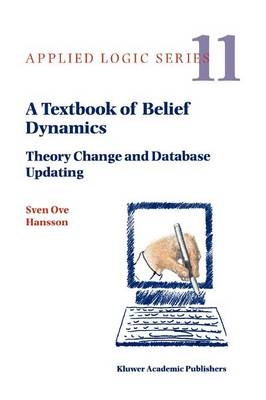
A Textbook of Belief Dynamics
Theory Change and Database Updating
Seiten
2010
|
Softcover reprint of hardcover 1st ed. 1999
Springer (Verlag)
978-90-481-5125-7 (ISBN)
Springer (Verlag)
978-90-481-5125-7 (ISBN)
The mid-1980s saw the discovery of logical tools that make it possible to model changes in belief and knowledge in entirely new ways.
The volume's unique, comprehensive coverage means that it can also be used by specialists in the field of belief dynamics and related areas, such as non-monotonic reasoning and knowledge representation.
The mid-1980s saw the discovery of logical tools that make it possible to model changes in belief and knowledge in entirely new ways. These logical tools turned out to be applicable to both human beliefs and to the contents of databases. Philosophers, logicians, and computer scientists have contributed to making this interdisciplinary field one of the most exciting in the cognitive scientists - and one that is expanding rapidly.
This, the first textbook in the new area, contains both discursive chapters with a minimum of formalism and formal chapters in which proofs and proof methods are presented. Using different selections from the formal sections, according to the author's detailed advice, allows the book to be used at all levels of university education. A supplementary volume contains solutions to the 210 exercises.
The volume's unique, comprehensive coverage means that it can also be used by specialists in the field of belief dynamics and related areas, such as non-monotonic reasoning and knowledge representation.
The volume's unique, comprehensive coverage means that it can also be used by specialists in the field of belief dynamics and related areas, such as non-monotonic reasoning and knowledge representation.
The mid-1980s saw the discovery of logical tools that make it possible to model changes in belief and knowledge in entirely new ways. These logical tools turned out to be applicable to both human beliefs and to the contents of databases. Philosophers, logicians, and computer scientists have contributed to making this interdisciplinary field one of the most exciting in the cognitive scientists - and one that is expanding rapidly.
This, the first textbook in the new area, contains both discursive chapters with a minimum of formalism and formal chapters in which proofs and proof methods are presented. Using different selections from the formal sections, according to the author's detailed advice, allows the book to be used at all levels of university education. A supplementary volume contains solutions to the 210 exercises.
The volume's unique, comprehensive coverage means that it can also be used by specialists in the field of belief dynamics and related areas, such as non-monotonic reasoning and knowledge representation.
Preface. Suggested Courses. 1. Having Beliefs. 1+. Basic Tools. 2. Giving Up Beliefs. 2+. The Logic of Contraction. 3. Taking on Beliefs. 3+. The Logic of Revision. 4. Hidden Structures of Belief. 4+. The Logic of Base-Generated Operations. 5. Believing and Hypothesizing. 5+. Extending the Formal Language. 6. Afterthought. 6+. Some Unsolved Problems. Suggested Readings. Bibliography. Symbol Index. Name Index.
| Erscheint lt. Verlag | 5.12.2010 |
|---|---|
| Reihe/Serie | Applied Logic Series ; 11/1 |
| Zusatzinfo | XII, 399 p. |
| Verlagsort | Dordrecht |
| Sprache | englisch |
| Maße | 160 x 240 mm |
| Themenwelt | Geisteswissenschaften ► Philosophie ► Allgemeines / Lexika |
| Geisteswissenschaften ► Philosophie ► Erkenntnistheorie / Wissenschaftstheorie | |
| Geisteswissenschaften ► Philosophie ► Logik | |
| Informatik ► Theorie / Studium ► Künstliche Intelligenz / Robotik | |
| Sozialwissenschaften | |
| ISBN-10 | 90-481-5125-2 / 9048151252 |
| ISBN-13 | 978-90-481-5125-7 / 9789048151257 |
| Zustand | Neuware |
| Haben Sie eine Frage zum Produkt? |
Mehr entdecken
aus dem Bereich
aus dem Bereich
Buch | Softcover (2024)
REDLINE (Verlag)
CHF 27,95
Eine kurze Geschichte der Informationsnetzwerke von der Steinzeit bis …
Buch | Hardcover (2024)
Penguin (Verlag)
CHF 39,20


